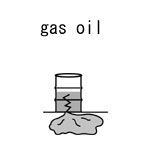| Case Name |
Leakage due to a crack of the weld part of a block valve for branched piping at a fuel oil hydrodesulfurization unit |
| Pictograph |

|
| Date |
May 17, 1984 |
| Place |
Ichihara, Chiba, Japan |
| Location |
Refinery |
| Overview |
A leakage accident happened during start-up operation after a turnaround shut-down of a fuel oil hydrodesulfurization unit in a refinery on May 17th, 1984. The valve on the piping connected to the instrument taking out section at the inlet of the high-temperature, high-pressure separator was damaged, and oil and gas leaked. Post-weld heat treatment of the valve was insufficient. The hardness of the welded part of the valve caused a crack in environmental hydrogen containing hydrogen sulfide, and a leakage occurred. |
| Incident |
Leakage occurred at a fuel oil hydrodesulfurization unit in a refinery. During start-up operation after a turnaround shutdown, a block valve on branched piping of the instrument taking out section at the inlet of a high-pressure, high-temperature separator broke, and oil and gas leaked. |
| Processing |
Manufacture |
| Individual Process |
Reaction |
| Chemical Reaction |
Other (hydro-desulfurization) |
| Substance |
Hydrogen, Fig2 |
| Gas oil |
| Type of Accident |
Leakage |
| Sequence |
On May 9th, 1984. Start-up operation started.
On May 12th -16th. Raw material (gas oil) feeding, warming, and pressurizing operations were carried out.
On May 17th, 08:55. The oil feed rate was 3200 kL a day.
10:30. Switching of feed oil from gas oil to heavy gas oil started.
12:28. Oil and gas leaked from the valve on the piping connected to a differential pressure gauge. An emergency shutdown of the unit started.
12:30. Urgent de-pressurizing operation started.
12:41. Pressure inside the system was lowered to 2 MPaG.
12:49. Introduction of nitrogen started because the pressure inside the system had lowered to 1.0 MPaG. |
| Cause |
It is considered that post-weld heat treatment for the valve had not been done properly.
Due to inadequate post-weld heat treatment, the hardness of the welded part was high. Therefore, it was considered that it cracked due to the effects of environmental hydrogen including hydrogen sulfide. |
| Response |
After the leakage, the unit was shut down immediately. Then, an urgent de-pressurizing operation was performed, and nitrogen was introduced into the plant. |
| Countermeasures |
1. Management of acceptance inspection of finished goods was reexamined.
2. Management of field construction work was made thoroughly. |
| Knowledge Comment |
In facilities management, detailed management including acceptance inspection of finished goods is needed. |
| Background |
There might have been a management failure related to the acceptance test for finished goods. However, the accident was inevitable on the user side. Usually, the user purchases the valve after designating the valve manufacturer and standards of the valve in detail. The quality of the products is guaranteed by the purchase contract. So, it might be very rare to do an acceptance test on the hardness and so on in Japan. |
| Reason for Adding to DB |
Example of a crack in the weld part under hydrogen atmosphere |
| Scenario |
| Primary Scenario
|
Poor Concept, Poor Strategy or Concept, Bad Selection of Manufacturer, Organizational Problems, Poor Management, Poor Management of Supplies Acceptance, Non-Regular Action, Inaction, Leave to Vendor only, Failure, Fracture/Damage, Crack, Secondary Damage, External Damage, Leakage
|
|
| Sources |
High Pressure Gas Safety Inst. of Japan. Fuel oil hydrodesulfurization unit. Hydrogen and fuel oil leakage from block valve and weld line crack of branched piping. Accident examples of Petroleum refinery and Petrochemical units. pp.38-44(1995).
|
| Multimedia Files |
Fig.2. Chemical formula
|
| Field |
Chemicals and Plants
|
| Author |
DOBASHI, Ritsu (School of Engineering, The University of Tokyo)
TAMURA, Masamitsu (Center for Risk Management and Safety Sciences, Yokohama National University)
|
|